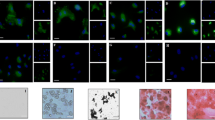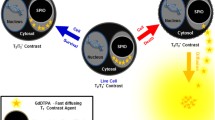Abstract
Traumatic brain injury (TBI) is a leading cause of death and disability. The condition is difficult to treat owing to its heterogeneous nature and complex biological pathways. Stem cell transplantation is an emerging self-deliverable therapeutic modality which could immensely improve the invigorating management of the problem. The synergistic interaction of the stem cells with the paracrine niche molecules at the site of injury is an end point that decides the cells’ effective tissue-forming regenerative response. Thus, noninvasive monitoring and tracking of the infused stem cells is quite decisive after transplantation. Here, we have designed and validated a distinctive in vivo magnetic resonance imaging protocol to monitor the transplanted mesenchymal stem cells (MSCs) longitudinally in TBI-induced mice. We have further described the synthesis of improved transverse relaxivity contrast agent, a protocol for the efficient labelling of MSCs, preparation of a TBI model system in mice, and the imaging and tracking of the implanted stem cells at the injury site through 7T MRI. MGE-T2∗ imaging in association with relaxometry-based quantitative assessment using absolute bias correction provided a suitable mechanism to monitor and track the infused labelled stem cells at the TBI site. High transverse relaxivity negative contrast agent synthesis, MSC labelling procedure, and quantitative T2∗ time measurement normalized with absolute bias correction are the key features of this protocol. This procedure has immense application potential and could therefore be extrapolated to stem cell tracking during the treatment of various diseases.
Access this chapter
Tax calculation will be finalised at checkout
Purchases are for personal use only
Similar content being viewed by others
References
Richardson RM et al (2010) Stem cell biology in traumatic brain injury: effects of injury and strategies for repair. J Neuro Surg 112:1125–1138
Mishra SK, Rana P, Khushu S, Gangenahalli G (2017) Therapeutic prospective of infused allogenic cultured mesenchymal stem cells in traumatic brain injury mice: a longitudinal proton magnetic resonance spectroscopy assessment. Stem Cells Transl Med 6:316–329
Park KJ, Park E, Liu E, Baker AJ (2009) Bone marrow-derived endothelial progenitor cells protect postischemic axons after traumatic brain injury. J Cereb Blood Flow Metab 34:357–366
Dharmasaroja P (2009) Bone marrow-derived mesenchymal stem cells for the treatment of ischemic stroke. J Clin Neurosci 16:12–20
Caplan AI, Correa D (2011) heMSC: an injury drugstore. Cell Stem Cell 9:11–15
Pittenger MF et al (1999) Multilineage potential of adult human mesenchymal stem cells. Science 284:143–147
Ma S et al (2014) Immunobiology of mesenchymal stem cells. Cell Death Differ 21:216–225
Karp JM, Teo GSL (2009) Mesenchymal stem cell homing: the devil is in the detail. Cell Stem Cell 4:206–216
Lee JS et al (2010) A long-term follow-up study of intravenous autologous mesenchymal stem cell transplantation in patients with ischemic stroke. Stem Cells 28:1099–1106
Kircher MF, Gambhir SS, Grimm J (2011) Noninvasive cell-tracking methods. Nat Rev Clin Oncol 8:677–688
Guzman R et al (2007) Long-term monitoring of transplanted human neural stem cells in developmental and pathological contexts with MRI. Proc Natl Acad Sci 104:10211–10216
Mishra SK, Khushu S, Gangenahalli G (2015) Potential stem cell labeling ability of poly-L-lysine complexed to ultrasmall iron oxide contrast agent: an optimization and relaxometry study. Exp Cell Res 339:427–436
Mishra SK, Kumar BSH, Khushu S, Gangenahalli G (2017) Early monitoring and evaluation of macrophage infiltration after experimental traumatic brain injury: a magnetic resonance imaging and flow cytometric analysis. Mol Cell Neurosci 78:25–34
Mishra SK, Kumar BSH, Khushu S, Tripathi RP, Gangenahalli G (2016) Increased transverse relaxivity in ultrasmall superparamagnetic iron oxide nanoparticles: applications as MRI contrast agent for biomedical imaging. Contrast Media Mol Imaging 11:350–361
Mishra SK, Khushu S, Gangenahalli G (2017) Biological effects of iron oxide-protamine sulfate complex on mesenchymal stem cells and its labeling optimization for cellular MRI. Exp Cell Res 351:59–67
Mishra SK, Khushu S, Gangenahalli G (2018) Effects of iron oxide contrast agent in combination with various transfection agents during mesenchymal stem cells labelling: an in vitro toxicological evaluation. Toxicol In Vitro 50:179–189
Mishra SK, Khushu S, Singh AK, Gangenahalli G (2018) Homing and tracking of iron oxide labelled mesenchymal stem cells after infusion in traumatic brain injury mice: a longitudinal in vivo MRI study. Stem Cell Rev Rep 14:888–900
Acknowledgments
We wish to thank Defence Research and Development Organization (DRDO), Ministry of Defence, Govt. of India, for providing S & T project (INM-311 & 323). Sincere thanks to the Indian Council of Medical Research (ICMR-25070/2014) for providing a Research Associate fellowship to Dr. Sushanta Kumar Mishra in support of the project.
Author information
Authors and Affiliations
Editor information
Editors and Affiliations
Rights and permissions
Copyright information
© 2019 Springer Science+Business Media New York
About this protocol
Cite this protocol
Mishra, S.K., Khushu, S., Gangenahalli, G. (2019). A Distinctive MRI-Based Absolute Bias Correction Protocol for the Potential Labelling and In Vivo Tracking of Stem Cells in a TBI Mice Model. In: Turksen, K. (eds) Imaging and Tracking Stem Cells. Methods in Molecular Biology, vol 2150. Humana, New York, NY. https://doi.org/10.1007/7651_2019_277
Download citation
DOI: https://doi.org/10.1007/7651_2019_277
Published:
Publisher Name: Humana, New York, NY
Print ISBN: 978-1-0716-0626-1
Online ISBN: 978-1-0716-0627-8
eBook Packages: Springer Protocols




